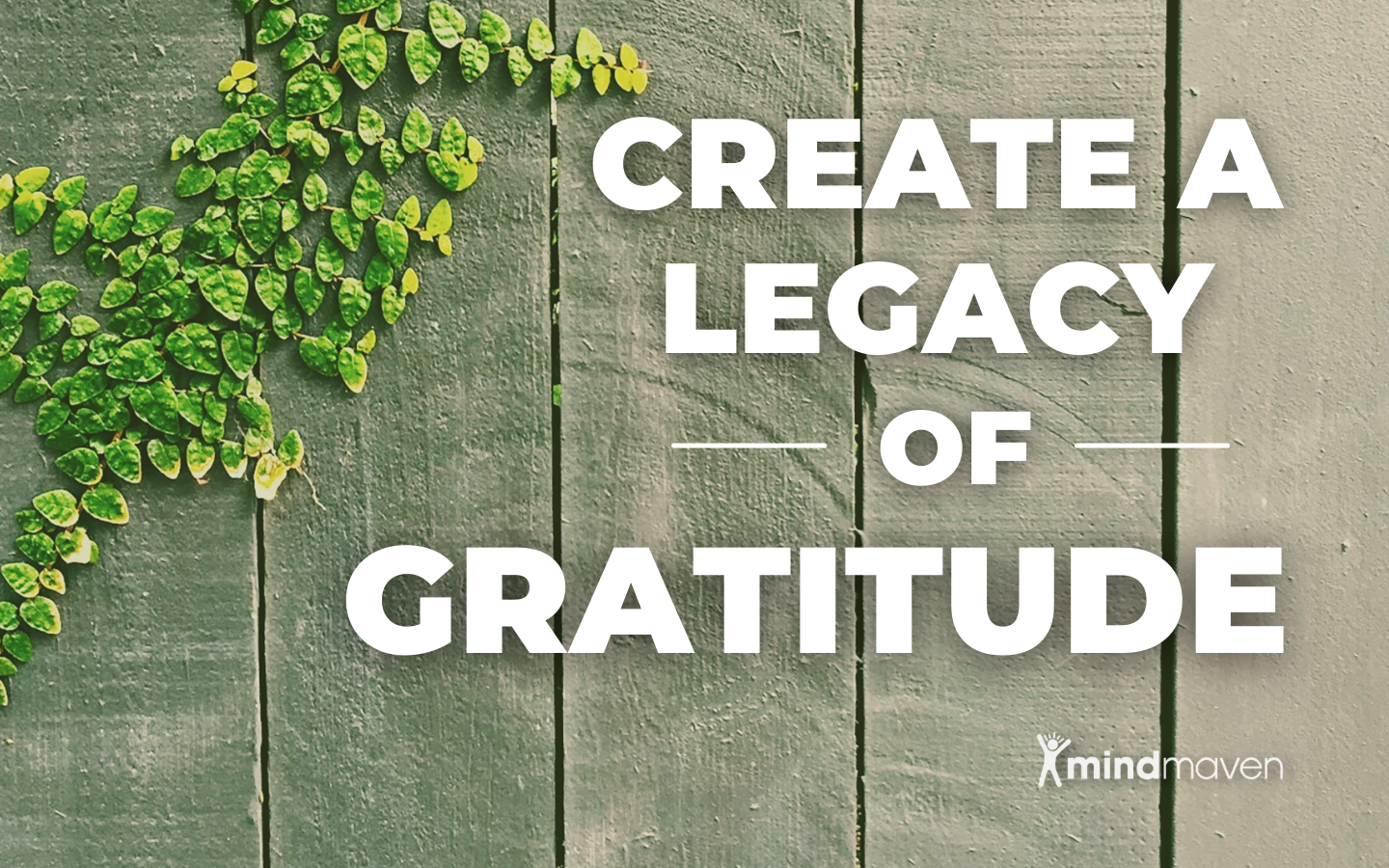
How to Create a Legacy of Gratitude (And Why You Should Want To!)
They tell us as children that please and thank you are the magic words, and even in business, saying “Thank you!” is one of the easiest ways to show appreciation and gratitude to people you care about or respect. Unfortunately, in a fast-paced, transaction-driven world, gratitude sometimes becomes little more than an automated response or formality. For example, when someone gives you a compliment, you’ll probably have the knee jerk reaction to say thank you—even if the compliment isn’t that meaningful!
And while socially expected moments are fine opportunities to say thank you, there’s a whole other dimension to gratitude that can leave lasting impressions on those who follow you and those you want to. This other dimension is what we call unexpected gratitude.
The Benefits of an Unexpected Thank You
An unexpected thank you is different from your typical thank you because it does not rely on a trigger happening in the moment. As a result, your gratitude comes as a pleasant, genuine, and heartfelt surprise to the other person.
Untriggered gratitude is so powerful because it isn’t done out of social obligation or rote muscle memory. The only reason for sending an unexpected thank you is genuine appreciation for that other person. Let’s look at three huge benefits of expressing thankfulness when others aren’t expecting it.
#1: You make the other person the center of attention.
Saying “thank you” as a response to a favor someone did for you focuses the moment on you. But reaching out to someone out-of-the-blue and thanking them for something unexpected, puts the limelight entirely on them. This will often lead to them feeling genuinely appreciated, and they’ll tie that positive emotion directly back to you.
#2: You prove you truly care.
When you thank someone—especially unexpectedly—you send a very clear message: I care about you and value our relationship. This also shows a person that you’re thinking about them at a time you might not be expected to; this will increase the chances of staying top of mind for them even when you don’t expect to be.
#3: You offer vulnerability.
By expressing gratitude, you’re making yourself vulnerable. You’re saying, “I couldn’t have done this alone. I needed your help, and I appreciate you.” Vulnerability is a powerful source of connection. By being vulnerable yourself, you give them the opportunity to do the same, often deepening the bond you share.
How To Be More Unexpected
Expressing gratitude in this way does not come easy for everyone, especially when we get super busy. You need to be intentional and proactive about seeking opportunities to do so.
Consider the following example:
It’s been six months since you were introduced you someone who became a major client. You sent a genuine thank you email immediately following the introduction, and that was the end of it.
But, six months later, you proactively send this email:
Hey Aisha,
I just wanted to reach out again and let you know how much I appreciate your introduction to Chuck awhile back. He became more than a great client but a friend as well, and it’s absolutely all thanks to you. You’re continued support and friendship means the world, and I wouldn’t be where I am without everything you’ve done for me.
Thanks so much,
Xander
Do you see how that would probably be more impactful than the thank you email you sent immediately following the interview?
Now we’re not saying you should stop using triggered gratitude. But you should start spending a little time each week intentionally thinking about who and what you’re grateful for, and then expressing that in a genuine, meaningful way.
21 Great Opportunities to Say an Unexpected Thank You
You can thank someone for just about anything so long as it’s genuine gratitude. Authenticity is key and inauthentic gratitude will usually be noticed and discarded by the recipient.
If you need some inspiration here are some of our favorite reasons to write a thank you email to someone in your network:
- Simply for being a friend
- For being a reliable business partner
- On the anniversary of having met one another
- On the anniversary of having signed an agreement
- For a small favor they did more than six months ago
- For the positive traits you appreciate about them
- For being a mentor
- For offering their unwavering support
- For never being judgmental toward you
- For offering advice that made a positive difference in your life
- For introducing you to someone of value
- For an idea or concept they gave you
- For being someone you can rely on
- For introducing you to a tool, software, or best practice you’re still using today
- For going above-and-beyond on something small
- For something they did for someone you care about
- For creating great content that has been valuable to you
- For telling you the truth (even when it’s hard)
- For inspiring you to overcome difficult odds
- For their honest insight and feedback on your work
- For being willing to meet you in the first place
This long list is just the beginning! There are literally hundreds of other reasons you could use. Consider scrolling through the names in your contacts, choosing someone at random, and asking yourself: “What about this person can I be thankful for?”
Saying Thank You More Often
The more you practice and express gratitude, the more you can enjoy the joys of a gratitude-oriented life—and your network will start noticing that’s the kind of person you are. To help you develop a legacy of gratitude, here are two powerful tips to turn thank you emails into an automated habit.
#1: Be Mindful of Any and All Value
Every time you perceive something of value, make a conscious note of it. Guaranteed, these thoughts happen more than you realize, and they often just slip by unnoticed.
Say a team member did an amazing job on a project. This potentially gives you a chance to thank two people: Both the team member and whoever introduced you to them. But that second person is almost never actually thanked.
Anytime you feel a “warm feeling” of gratitude, pause, and ask yourself: “Why am I feeling this?” you can likely trace it back to a person (or people) who helped you feel that way. And if so, thank them!
#2: Intentionally Seek Gratitude
If you’re like most people, you probably experience “warm feelings” of gratitude many times over the course of the day. The trick is to train yourself to be aware of them.
This takes practice and effort. Let us help you get the ball rolling with a quick exercise. We’re going to find ten people in your network you can send a thank you email to. Here’s what I want you to do:
- Go back to the list of 21 reasons to express gratitude. Think about each item on the list for 30-45 seconds. Do any names come to mind?
If you’re on the “Say thank you to a mentor” item, ask yourself who has given you valuable advice, no matter how small. Or think about a time you were struggling. Who was there to help?
If you’ve been in business for more than five years, you’ll probably come up with at least ten names. And once that list is complete, figure out who hasn’t heard from you in the last 30 days.
If it’s over 50%, you’re likely missing out on valuable opportunities. There’s a good chance most people on that list would appreciate an unexpected thank you, so start writing!
Bonus: How to Integrate Gratitude into Your Workflow
Here at Mindmaven, we love to automate as many workflows as possible, and this is no different. If your CRM program or contacts database has an automated alert system for when you haven’t had contact with someone in a set amount of time, this is a great place to start.
First, create a temporary category in your CRM specifically for “thank you” targets. Add all the people you came up with in the exercise above (and more if you can).
Then, in each contact’s notes section, briefly write your reason for thanking them. This makes it easy to draft an email when the time comes.
And when you get that alert that it’s been more than 30 days since your last interaction, all you’ve got to do is open their profile, review your “thank you” notes, and write the email!


